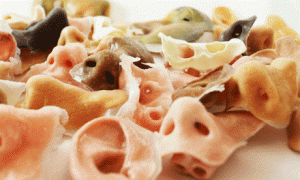Amazing innovative technology was created to rebuild the human face with 3D printing in silicone.
English chemist Frederick Kipping did his pioneering work on the study of the organic compounds of silicon which led to synthetic rubber and silicone-based lubricants used to enhance the decollete of dancers, seal fish tanks and now rebuild the human face.
Industrial designer Tom Fripp was contacted by researchers at the University of Sheffield and asked if it would be possible to print structures which bear a close resemblance to human soft tissue.
Following a number of years of collaborative work and prototyping it is now possible for facial parts to be printed in 3D natural full color via a process which uses starch powder to form a model which is then vacuum-formed with medical grade silicone.
The components are bound together and the resultant prosthetic is both durable and flexible. This will be very helpful for people in need of cosmetic facial replacement via 3D printing.
The initial work may cost about the same as parts made with traditional processes but each part but thereafter can be re-created for a subsidized amount. This method would turn out cheaper and quicker than the traditional method which relies on molding and casting and takes very long.
The process involves a patient’s face being scanned in 3D and contours are then added to a digital model of the prosthetic part which allows for a perfect fit with accuracy and without pain. The critical component of the process is to first entirely print the part in silicone as this process helps eliminates unsightly white lines which often form around the boundaries of a prostheses as silicone reacts with starch.
While prostheses can eventually wear out from exposure to sun and water, 3D printing simplifies the process and thereby allows for a much greater range of customization per an individual patient’s requirements.
With this latest technology a patient could get a nose or ear printed within 48 hours which once took ten weeks.
This technology once is cleared by testing and health service, might be ready within a year.
For more information please visit:
http://www.inventor-strategies.com

